A Pressure Washer's Guide to Adding Water Fed Pole Cleaning
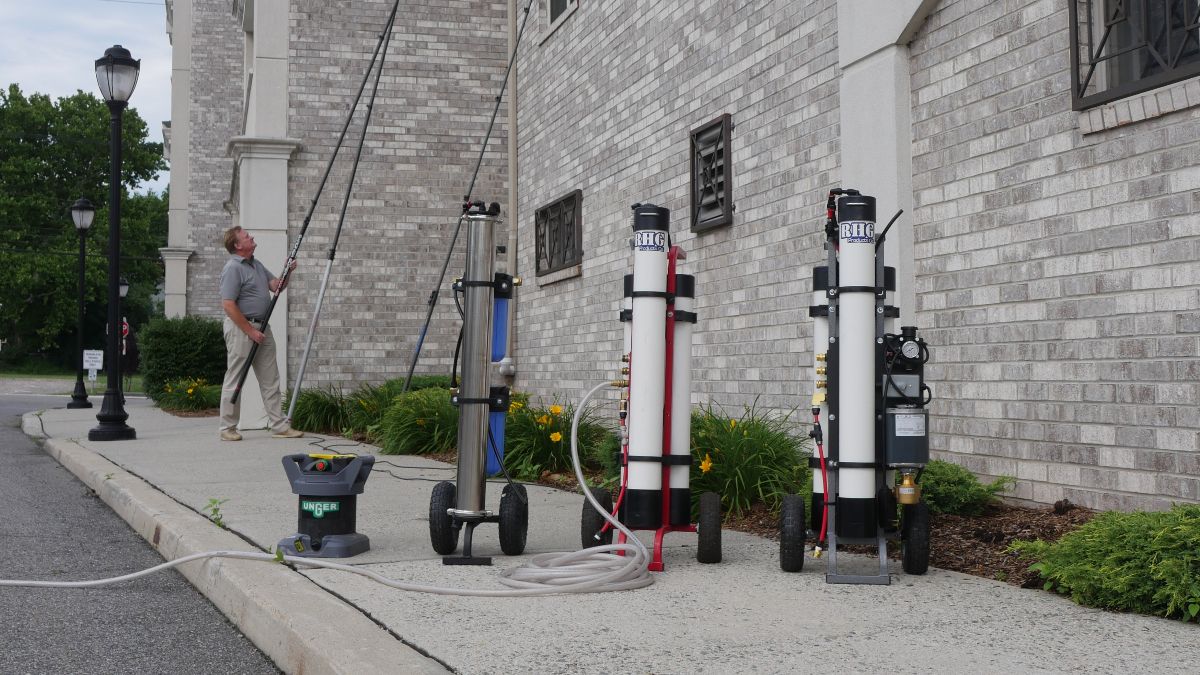
If you own a pressure washing or soft washing business, you’ve probably already experienced your customers asking "can you clean my windows too?” For years, pressure washing and window cleaning were two entirely different entities. However, more and more companies are realizing that not doing both often means leaving money on the table.
Pressure washing and soft washing companies are sometimes hesitant to add window cleaning, especially using a mop and squeegee. But the growth of today’s water fed poles puts that concern at bay, allowing for quick, thorough cleanings, without the need for ladders and a lot of extra equipment.
Let’s look at a few basic questions you may have:
1. Why Should I Add Window Cleaning?
Adding window cleaning means you’ll be getting more money out of your current customers, and upselling a current customer is much easier than finding a new customer. Not to mention you’ll be saving on travel expenses and time.
Secondly, window cleaning can also lead to more pressure washing, soft washing, gutter cleaning, and even interior dusting (especially if you use our Gardiner 3-in-1 system) clients. Small jobs can easily turn into much larger jobs.
Window cleaning services typically happen more frequently – e.g., two or four times a year – as opposed to pressure washing, that’s more like once every two years. This not only results in extra income from window cleaning, it also means your company will be in front of your customer much more often, staying on the top of their mind – and list – when it comes to choosing cleaning services.
Waterfed pole systems make it easier than ever to provide exterior cleaning. While window cleaning generally does not bill out as much as pressure washing, the equipment doesn't have to cost nearly the amount that pressure washing equipment does, and it's pretty common to make around $100 to $150 an hour.
Lorem Ipsum is simply dummy text of the printing and typesetting industry. Lorem Ipsum has been the industry's standard dummy text ever since the 1500s, when an unknown printer took a galley of type and scrambled it to make a type specimen book.
2. How do I choose a Water Fed Pole?
A quick note: Most basic window cleaning jobs can be done with a water fed pole. However, there are some windows -- especially those with things like hard water stains, bird droppings, stucco overspray, etc. -- that need to be cleaned manually (i.e., mop and squeegee), so you will either need to invest in and learn how to use these tools, or pass on those jobs.
One of the most important tools for water fed pole cleaning is, of course, a water fed pole.
However, not all water fed poles (WFPs) are the same.
WFPs come in different lengths, quality, and price ranges. Cheaper models are usually made from less expensive material, such as aluminum or fiber glass, and are heavier and less rigid (or "floppier"). This makes them more difficult and tiresome to use, which can ultimately lead to reduced quality of work, slower production, and more potential for injury.
We recommend Gardiner poles. Not only are they the strongest, lightest poles in the WORLD, they are modular -- meaning you can add sections to reach greater heights. Yes, there are some other modular poles on the market, but none are as rigid or lightweight as a Gardiner. The lighter and more rigid your WFP, the easier and less tiring it is to use. Easier cleaning means more productive workers, and that, in turn, means more profit.
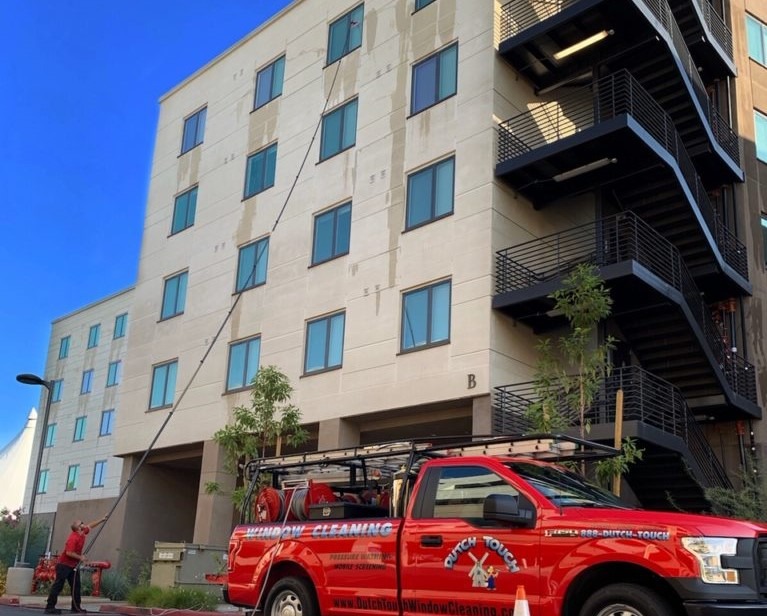

Which Pole Should I Buy?
There are lots of water fed pole options these days, especially when it comes to length and material, and the prices range accordingly. When determining which pole you need, keep these questions in mind:
How many stories high will I be cleaning? If you are mostly cleaning residential, then a 25 to 35 foot pole is probably enough. If you are wanting to do commercial, then we carry poles that can reach up to 96 feet. You can learn more about choosing the right WFP for you in our Water Fed Pole Height Guide
How often will I be cleaning? Less expensive poles are usually made from aluminum or fiber glass tubing, which is heavier and “floppier,” so they are more difficult to handle and more cumbersome to use.
If you’re going to be cleaning more often, a carbon fiber or hybrid pole is a better option and a smart investment. The lighter and more rigid the pole is, the easier it is to use, the kinder it is on your joints, and the more efficiently you can clean. Remember, efficiency equates to more money.
The Gardiner CLX 27 foot Hybrid Complete is one of our best selling residential poles, and generally a good option for many pressure washing companies who primarily want to offer their 1-3 story residential customers window cleaning services. It's a 6-section telescopic carbon composite pole, made of 65% carbon fiber.
If you're wanting to reach greater heights, we offer Gardiner pole options that go all the way up to 96 feet! Gardiner is the best pole on the market -- lightweight and rigid, a winning combination!
You can learn more about choosing the right WFP for you in our Water Fed Pole Height Guide
What all do I want to clean with the Water Fed Pole?
Our Gardiner pole system can be used for windows, gutters, high interior dusting, and even roof cleaning! You simply use the same basic pole then switch out the attachments.
With a few simple twists of the wrist, your Gardiner #10 pole extensions can easily be transformed into three types of cleaning poles, providing a cost-effective, flexible, and efficient solution for cleaning high-level areas safely from the ground.
All three systems offer the quality, rigidity, flexibility, and reliability that has made Gardiner the top-selling pole in the UK and a favorite among our customers. It's sturdy for many seasons of use and not prone to cracking.
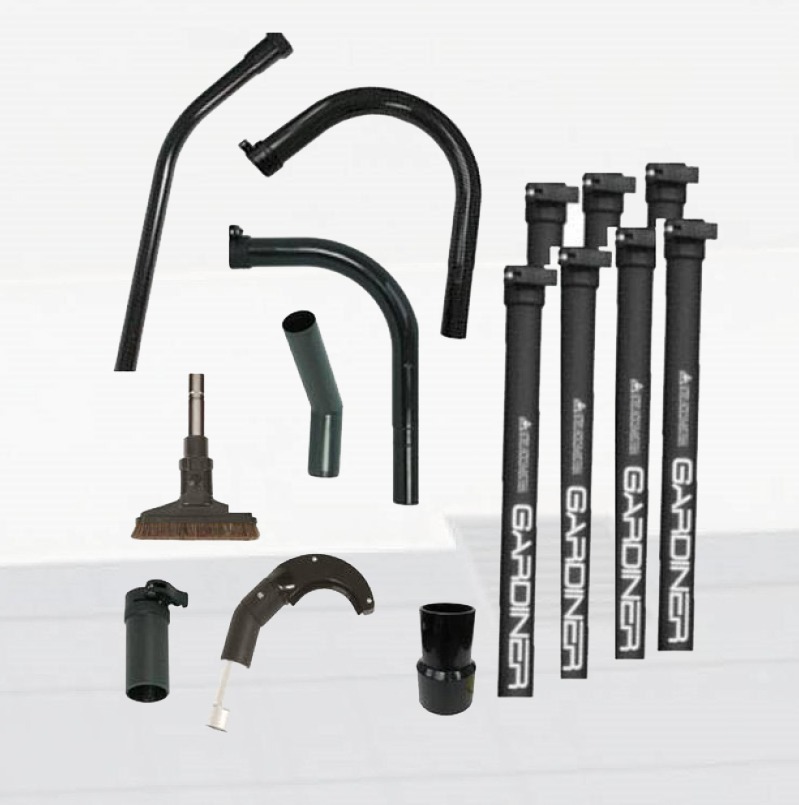
3. How will I produce pure water?
Pure water is a natural cleaner, and when used correctly, it leaves no residual spotting. Pure water cleans by attracting dirt from the surface like a magnet. It's pure and wants to get dirty again. Once it collects the dirt, it drags the dirt down to the ground.
To get pure water from tap water, you have to first remove the dissolved solids that are held in suspension in the water.
When selecting the best water purification system for you, you need to start by using a TDS meter to get a quick reading of your Total Dissolved Solids. (You may be able to find this through your local water company, but we still recommend keeping a TDS meter on hand.)
If your TDS reading out of the faucet is under 120 and you won't be cleaning a lot of windows each week, a DI tank -- like the Unger HydroPower nLite DI System -- may be all you need. The HydroPower nLite is small, easy to use, and has a TDS meter directly mounted on top. However, because DI resin is expensive, it's often more cost-effective to have an RODI system.
If your TDS is over 120, go with a RODI System. This consumes 95% less DI resin, saving you money in the long run.
RODI systems contain three filtration systems:
1. A carbon filter to absorb the chlorine (which otherwise damages the RO membrane)
2. The RO Membrane, which removes about 95% of the remaining contaminants
3. The DI Resin, which reduces your TDS to below 10, ensuring spot-free cleaning.
ProTool DIY RODI Wall Mount System
The most efficient and powerful system available anywhere is our ProTool DIY RODI system. Available in several different versions, the system produces more water than any other system out there, allowing you to work faster, higher, and with more users at once. And the cost is comparable to less-efficient RODI carts on the market.
The wall-mounted system is similar to using a skid versus a portable pressure washer. With the convenience of our wall-mounted system, you save coveted floor space and time from not having to run pull a cart in and out of your truck or van.
While you have do have to mount the system yourself, we've done the hardest parts for you. The kit ships with posts for mounting the pump, electrical wiring completed, and the bracket/metering system mounted. Just install pumps and connect the quick connects and you are ready to clean. Each system also comes with a thorough instruction booklet, and our customers service team is available to answer any questions you may run across.
And because you are putting the system together yourself, the system saves on labor and shipping, letting us pass the savings on to you. You get a much more efficient system for a comparable price to RODI carts.
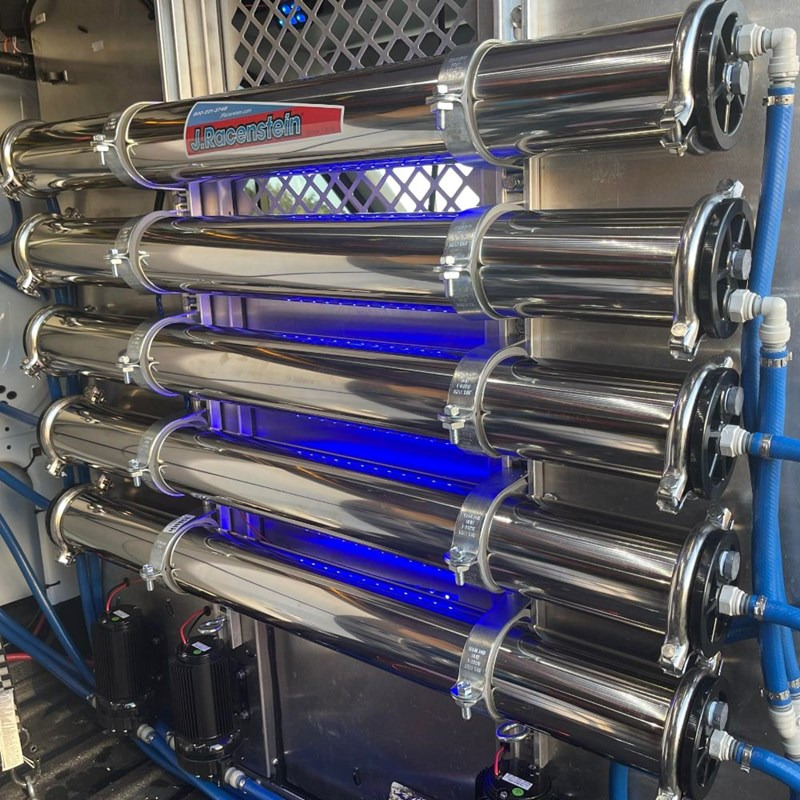
For those who don't have wall space in their truck or van, we recommend the ProTool Flat Pack Cart.
The quality system features a 40" RO filter, a 20" carbon filter, and a 20" refillable DI filter, steel frame, wide base for better stability, and more. Bigger filters mean they last longer, saving you time and money. The ProTool RODI Cart comes with best-in-class DI and carbon filters that are 9 times longer! This means less frequent changes and more time on the job.
Because assembly is required, you get a much better cart for less than lower-quality systems. We provide everything you need for assembly and detailed step-by-step instructions.
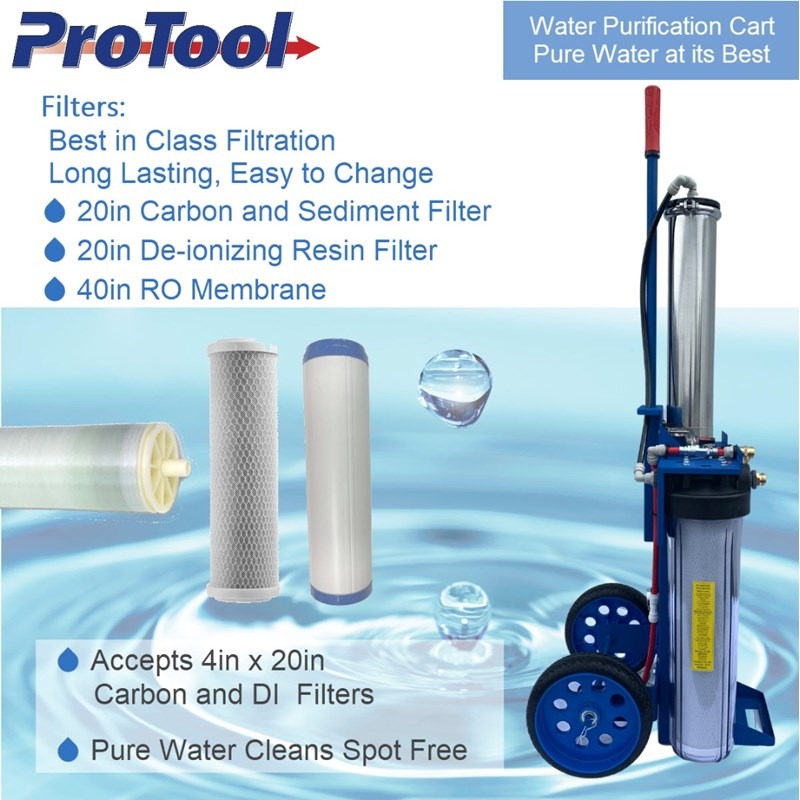
4. Which brush should I use?
The final piece of the WPF system is the brush.Keep in mind that the brush is what cleans the window; the DI water is what rinses it off.
When it comes to choosing which brush (or brushes) you want to attach to the end of your water fed pole, a lot of it is dependent on personal preference as well as your budget. Brushes come in different sizes (generally 12 or 18 inch), different bristles (mostly nylon or boars hair), and with different spray jet configurations.
- Nylon Brushes do not hold on to dirt, which means you do not lift off the glass to rinse. Simply add a little pressure to the glass when clean, then lessen the pressure when you rinse. These are generally your least expensive options.
- Boar's Hair Brushes are denser, and do hold on to dirt, which means they clean faster, especially on dirtier windows. Boars hair is coarser, and gives a little stronger agitation for removing dirty areas. Because it is a natural fiber, it is more expensive.
- Hybrid Brushes are a combination of nylon and boars hair, typically nylon around the outer edges, and a shorter-length boars hair in the middle. This lets you scrub harder areas with the boars hair (by pushing harder against the glass), but doesn't require removing the pole from the glass to rinse.
In addition to the type of fiber used, different brushes have different rinsing setups. For example, the Tucker Over-the-Top brush has a rinse bar that sprays above the brush.
Gardiner brushes use a quick lock rather than threading, which makes it easier and faster for changing out brushes in the field. Note: we can modify any brush to fit a Gardiner pole!
This completes your basic Water Fed Pole setup.
Keep in mind that while water fed pole cleaning is easier to learn and master than traditional window cleaning, there is a learning curve. Don't give up! It takes practice to get the results you want, but you can likely learn to do it correctly within a week. And remember, the J. Racenstein is always ready to answer any questions you may have. Your success is our success!

